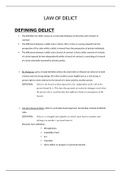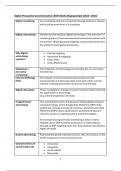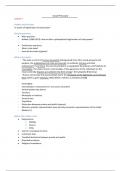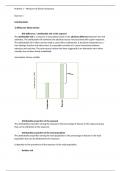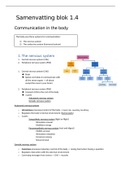A LEVEL NOTES
Marlowe Taylor
,Contents
Periodicity (2.1) .................................................................................................................. 2
Classification (2.1.1).................................................................................................................................................... 2
Physical properties of Period 3 elements (2.1.2) ........................................................................................................... 2
Group 2, the alkaline earth metals (2.2) ................................................................................ 3
Group 7 (17), The Halogens (2.3) ........................................................................................... 5
Trends in properties (2.3.1) .......................................................................................................................................... 5
Uses of chlorine and chlorate(I) (2.3.2) ......................................................................................................................... 6
Properties of Period 3 elements and their oxides (2.4) ........................................................... 7
Transition metals (2.5)......................................................................................................... 9
General properties of transition metals (2.5.1).............................................................................................................. 9
Substitution reactions (2.5.2) ..................................................................................................................................... 10
Shapes of complex ions (2.5.3) .................................................................................................................................. 11
Formation of coloured ions (2.5.4) ............................................................................................................................. 12
Variable oxidation states (2.5.5) ................................................................................................................................. 14
Catalysts (2.5.6) ........................................................................................................................................................ 16
Reactions of ions in aqueous solution (2.6) ......................................................................... 19
Page 1 of 21
, Periodicity (2.1)
Classification (2.1.1)
- Periodicity = the regular recurrence of properties of elements when
they are arranged in atomic number order, as in the periodic table
- Elements are classified as s, p, d, or f blocks according to which
orbitals the highest energy electrons are in
Physical properties of Period 3 elements (2.1.2)
Trends across Period 3 (Na – Ar)
Atomic radius DECREASES: - Nuclear charge increases so outermost electrons are
pulled in closer to nucleus
.
- Shielding stays the same, so outermost electrons are in the
same shell
First ionisation energy - Nuclear charge increases, atomic radius decreases, so
INCREASES: attraction on outermost electrons increases, making them
harder to lose. Shielding is constant
- G2-3 dip: Al’s electron is removed from a 3p orbital which is
higher energy than the 3s orbital, so needs less energy to
remove
- G5-6 dip: S loses its electron from an orbital with 2
electrons in it, while P loses its electron from an orbital
with 1 electron in it. S has additional electron-electron
repulsion, reducing the energy required to remove it
Electronegativity INCREASES: - Nuclear charge increases, atomic radius decreases, so
strength of nuclear force attraction increases – attraction
on the 2 electrons in a covalent bond is stronger
Melting and Boiling points: - Na to Al: metallic bonding – strength of metallic bond
increases as nuclear charge increases and atomic radius
decreases
- Si is macromolecular so strong covalent bonds take lots of
energy to overcome
- P, S, Cl are all simple covalent: S8 > P4 > Cl2 in terms of size
and melting point: large molecule means stronger van der
Waals forces – takes more energy to overcome. IMFs are
very weak so take much less energy to overcome than
metallic or covalent bonds – MP is lower
- Ar is monatomic so has very weak van der Waals IMFs –
takes v little energy to overcome
Page 2 of 21


